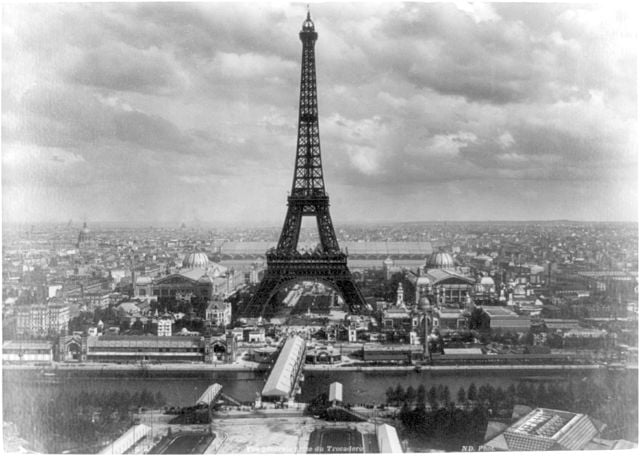*Image Credit: Wikimedia Commons Stretching more than a thousand feet above west-central Paris, the Eiffel Tower is one of the world’s iconic structures. Opened on March 31, 1889, the “Iron Lady” — the tallest manmade object on the planet for more than four decades — has had more than 250 million visitors since. During the sunny spring of 1884, Maurice Koechlin and Emile Nouguier came up with an idea for a massive latticework tower as the focal point of the 1889 Exposition Universelle in Paris. Inspired to push the limits in a bid to honor the 100th anniversary of the French Revolution, the two engineers for the Compagnie des Establissements Eiffel produced a fast sketch for a slender pyramid stretching into the sky. Gustave Eiffel, unimpressed, set aside his indifference to allow Koechlin and Nouguier to pursue the concept further. Turning to Stephen Sauvestre, the lead architect for the company, the engineers hoped to turn the stark iron structure created by Koechlin into an eye-catching marvel. In adding some subtle details — particularly softening the structure by giving it deeper arches — Sauvestre’s treatment on the tower ignited Eiffel’s passion for the project. As the leaves changed color during the autumn of 1884, the three-person design team presented the preliminary idea to the Exhibition of Decorative Arts. Though Eiffel made a compelling case for building the tower in March 1885, it took almost a year for any movement to occur — funding for the Exposition had to be approved by the French government. With the money allocated early in 1886, President Edouard Lockroy announced the parameters for a centerpiece on May 1st. The Eiffel design already fit the proposed dimensions for the four-sided structure on the Champ de Mars and, after a six-week competition, was announced as the winner. With the details finalized over the next half-year, Eiffel became a target for criticism. As construction began in January 1887, a number of prominent French artists lodged a protest in the Paris newspaper Le Temps, calling the “monstrous Eiffel Tower” an eyesore next to the beauty of the Arc de Triomphe and Notre Dame cathedral. Construction would move along at a brisk pace — once the foundations were completed at the end of June 1887, the Eiffel Tower rose at a rate of almost two feet per day, an astounding fact considering more than 18,000 parts had to be pieced together with extreme precision. By March 1888, the legs were joined together, allowing the remainder of construction to accelerate to the finish. Throughout the project, Eiffel impressed the importance of safety upon his workers. As creeping cranes crawled along the ironworks further into the sky above Paris, guard rails and screens moved along with them. By paying such close attention to the measures available for his employees protection, the number of fatalities during construction was limited to a solitary death, that of a riveter’s assistant named Dussardin. On March 31, 1889, just days after the final piece of the tower was put in place, Eiffel proudly led a number of government officials and journalists to the apex of the structure that bears his name. During the hour-long walk to the top, Eiffel beamed as he pointed out the small factors which made the larger design so grand. When he reached the 980-foot-high upper level with a few brave members of the tour group, Eiffel unfurled the French flag to a 25-gun salute commemorating the completion of the tallest structure in the world at the time. Despite the main construction being complete, the Eiffel Tower was not yet ready to receive the public. Elevators and observation decks were not in place with only five weeks remaining until the opening of the Exposition. The tower finally opened on May 15th — 9 days late — and still offered people nothing but steps for the trip up through the structure. No one was deterred: more than 2 million people visited during the six-month fair. Originally, the City of Paris intended to take the structure down after two decades. Advances in radio technology, however, made that impossible — the Eiffel Tower made an excellent radio antenna, even being used to disrupt German communications during the First World War. In 1930, the Chrysler Building in New York City took over as the world’s tallest structure. While the Germans occupied Paris during World War II, legend has it Adolf Hitler refused to make the climb to the top, leaving some to say he “conquered France, but the Eiffel Tower conquered him.” With the Allies approaching in August 1944, Der Fuhrer ordered the landmark destroyed in order to damage French morale but General Dietrich von Choltitz — thankfully — ignored the Nazi leader. For more than 120 years, the Eiffel Tower has been a must-see for any tourist making a trip to Paris. Well over 250 million people have forked over a few francs to climb up into the structure, making it the most-visited paid attraction in the world, by far. Also On This Day: 1492 – Queen Isabella of Castille instates the Alhambra Decree, designed to force 150,000 Jews to convert to Christianity 1596 – French philosopher Rene Descartes is born 1854 – The Treaty of Kanagawa opens the Japanese ports of Shimoda and Hakodate to trade from the United States 1909 – Construction of the RMS Titanic begins in Belfast, Ireland 1959 – Tenzin Gyatso, the 14th Dalai Lama, crosses over into India and receives political asylum after the Tibetan Rebellion Click here, to learn more about Eiffel tower tickets, height, best time to visit, opening hours and its location map.
March 31 1889 – The Eiffel Tower Opens
*Image Credit: Wikimedia Commons Stretching more than a thousand feet above west-central Paris, the Eiffel Tower is one of the world’s iconic structures. Opened on March 31, 1889, the “Iron…
452
